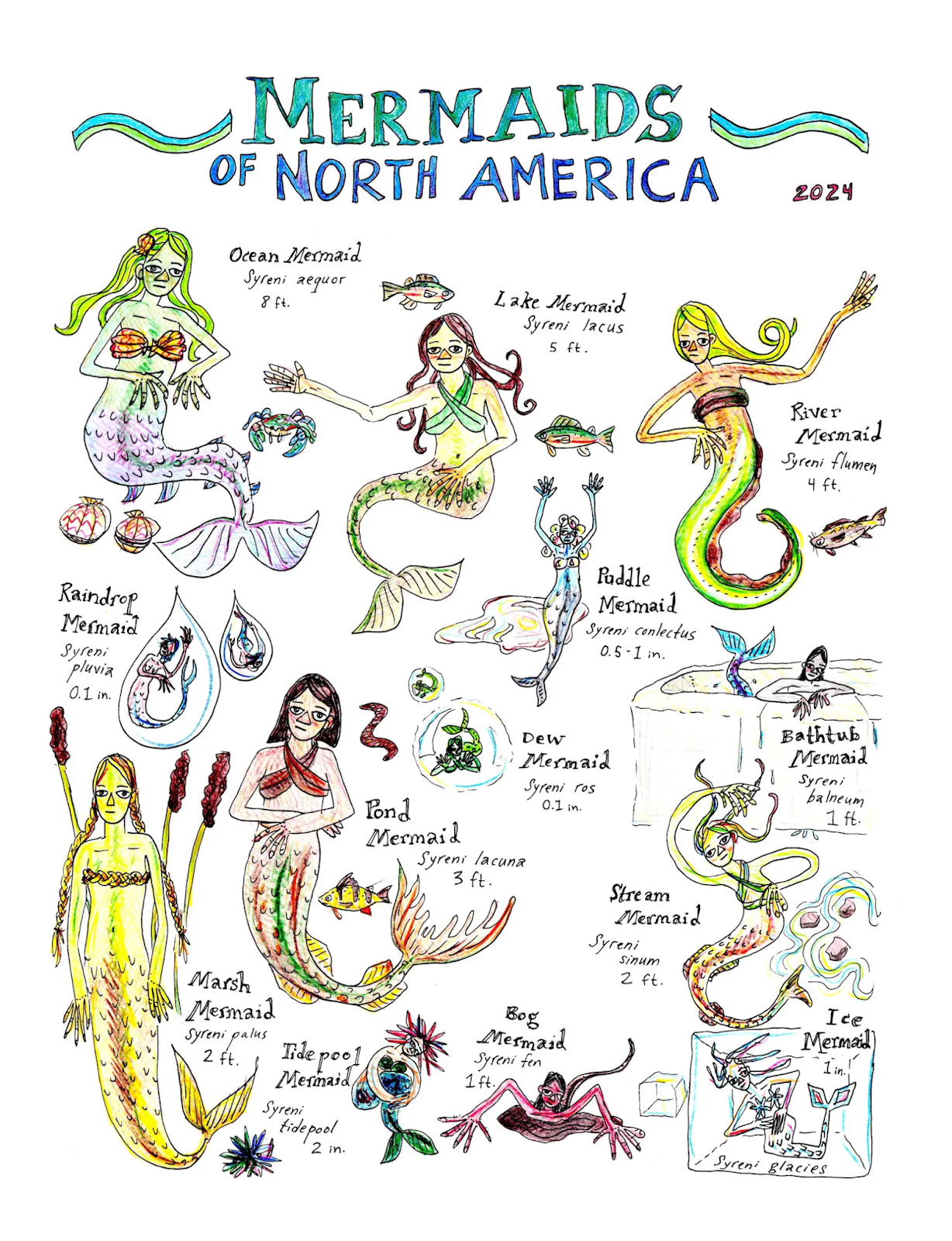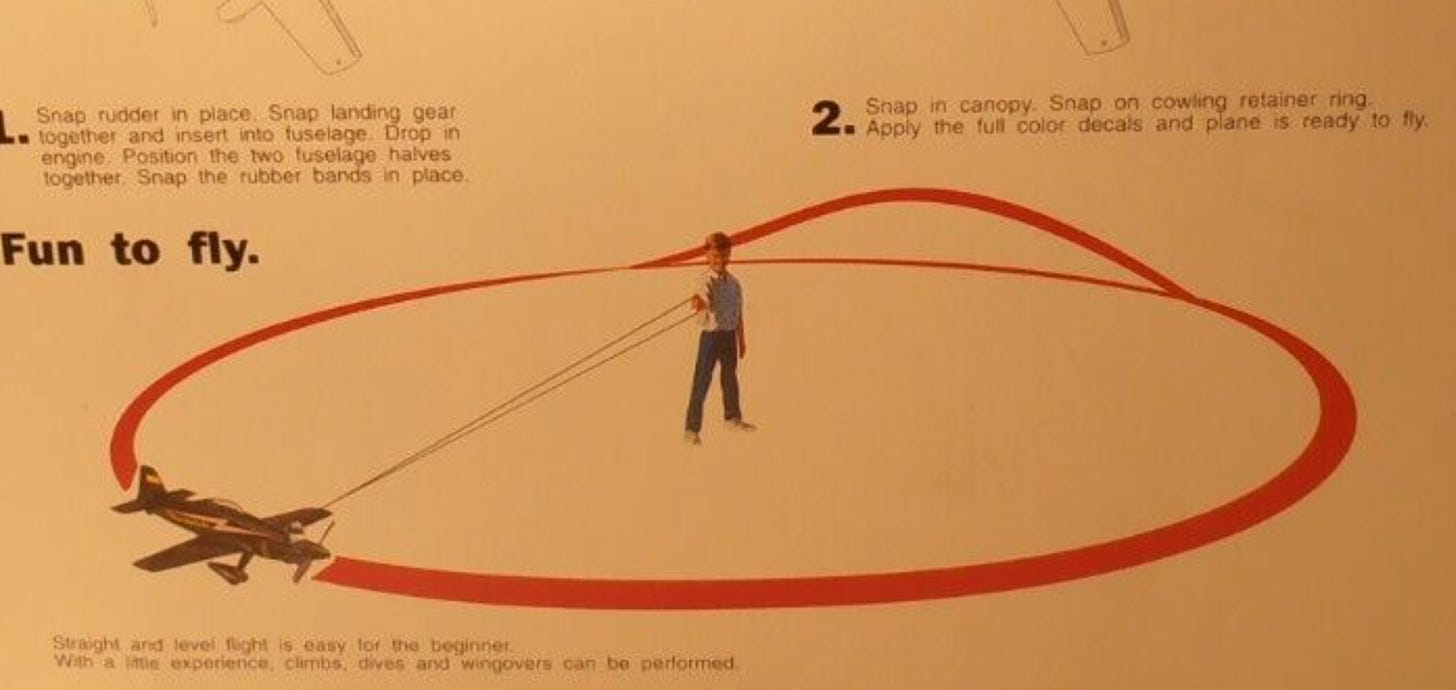Mark Slavonia | November 14, 2024
The World's Most Dangerous Toy Edition
On fun, danger, and 1970s model airplanes.
Re-running one of our greatest hits today, for subscribers who’ve joined us since 2022 and would have missed it. It was written by Mark Slavonia (MJS), a friend of WITI and an investor, pilot, and avid cyclist. He’s written for us about tall trees, radio beacons, rowing machines, traveler’s checks, and more. He posts other things that are interesting on his website. Enjoy - LC.
Mark here. It’s hard to exaggerate the allure of the Cox E-Z Flyer. To a young boy in the late 1970s, the Cox E-Z Flyer was the best toy in the world. It was also loud, dangerous, and doomed.
Why is this interesting?
The Cox E-Z Flyer was a control-line model airplane powered by a tiny internal combustion engine. It was attached to two 50’ control lines that ran to a handle. The model airplane enthusiast would hold the handle as the plane spun in a 100’ diameter circle around the pilot until it ran out of fuel or crashed. These two outcomes were equally likely.
Theoretically, the control lines allowed the pilot to perform tricks and maneuvers with the plane by tilting the handle to manipulate the plane’s control surfaces. However, as a practical matter for most Cox EZ-Flyer owners, this illusion of control only served as a temptation to stray from the only prudent flight plan, which was level flight until fuel exhaustion.
Did the pilot get dizzy? Yes.
Could a passerby get snared in the spinning control line such that the plane circled closer and closer on an ever-tightening death spiral until the whirling propeller and the incandescently hot metal engine collided with its victim? Theoretically, I guess. But it seems more likely that the plane would lose vertical control and crash long before this, leaving the pilot and the victim to explore concepts such as fault, responsibility, and liability.
Our friend Edith Zimmerman—an occasional WITI contributor and author/illustrator of the excellent Drawing Links—has started an Etsy store to sell her art. We like promoting our friends, and you should be getting your holiday shopping done early. Shop her full store here.
Because the Cox E-Z Flyer began its inexorable motion immediately upon starting, it required two people to operate: the pilot and someone to start the plane. Starting a Cox E-Z Flyer had its own challenges and dangers. The starter would hand-crank the tiny, sharp propeller like an old-time barnstormer. A small spring hooked around the propeller. The starter would spin the propeller backward against the spring, then flick it to release the prop, hoping the engine would kick into life. Frequent mis-starts encouraged the starter to ever more enthusiastic prop-flicking, which increased the chances that when the tiny engine burst into life, the starter’s fingers would be in the path of the propeller. Typing this paragraph vividly evokes the sting of a fresh cut on gasoline-soaked fingers.
Starter/crowd control was this writer’s assigned serfdom—since the Cox E-Z Flyer that came (briefly) into our house was the property of my eleven-year-old brother. At age nine, all I got to do was struggle to start the plane and then hold back the curious neighbors, dogs, and occasional motor vehicle traffic as my brother spun his orbits around our cul-de-sac.
My crowd control efforts were made easier by the shockingly loud buzz emitted by the tiny 0.049 cubic inch two-stroke engine. These adorable powerplants are called “glow plug” engines because the fuel is ignited by the glowingly hot engine itself. In the unlikely event of a successful flight, the enthusiastic pilot would no doubt want to fly again immediately, leaving the starter to try to refuel and re-prop an engine that was literally hot enough to ignite its own fuel. A precise blend of fuel and lubricant was required, both helpfully sold and supplied by the Cox Model Engine Company.
One day, after my brother had pulled off another flawless full-tank-to-exhaustion rotating flight on our cul-de-sac, I managed to wheedle and whine enough to get him to allow me to fly his plane. Our very poor idea was for him to begin the flight (I’d prop and start the plane as usual), then I’d dash to the center of the 50’ radius, grab the control handle from him, and continue the flight. This did not go as planned. The moment of slack created when we handed off the controls sent the plane into a climb, then an unrecoverable dive. The little plane crashed into the pavement and burst into dozens of pieces of sharp plastic and hot metal. My relationship with my brother suffered similarly irreparable damage.
Control line model aviation is a rich and rewarding hobby pursued with great skill and care by enthusiasts all around the world. The Cox E-Z Flyer may have been an excellent model for the hobbyist, but as a toy for children, it was terrible, sure to end its short service life in tears and flame. You may be thinking that the Cox E-Z Flyer was never intended for children and that it only fell into the hands of kids who adroitly manipulated their parents into buying them a gift intended for adults. But no, dear reader. Take a look at this:
This is the back of the box for the Cox E-Z Flyer. How old is that hobbyist? Nine?
The Cox Hobbies company merged with the equally exciting Estes Model Rockets in 1996, but competition from inexpensive electric-powered, radio-controlled aircraft spelled the end of production soon thereafter. Dedicated fans of Cox’s tiny internal combustion engines keep a market alive for parts and fuel, and Cox E-Z Flyers are available from time to time on eBay. Serviceable models can be found for about $200. (MJS)
Quick Links:
This introductory video for control-line flying, “Wired for Excitement”, is narrated by the great John Facenda of NFL Films fame.
Brodak.com covers all things related to control-line flying.
The Wikipedia page for the Cox model engine.
First flight video of a New-In-Box Cox E-Z Flyer of the same type and model that I famously crashed. “They don’t make educational toys like this anymore”- Educational?





